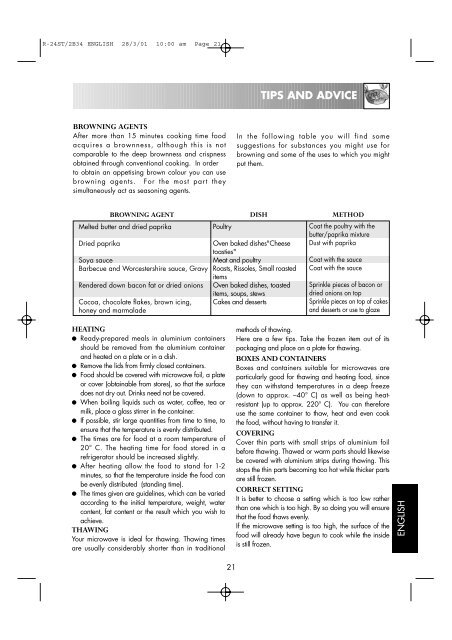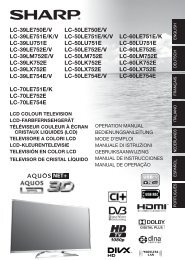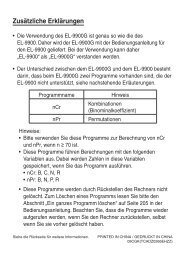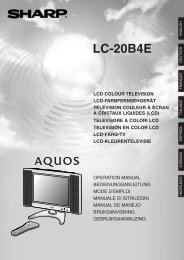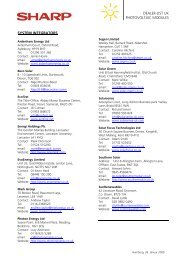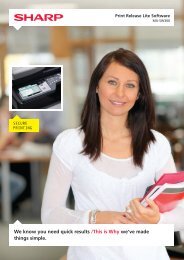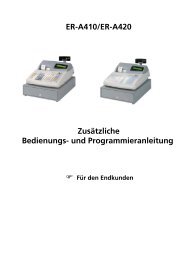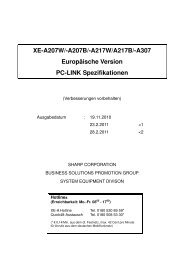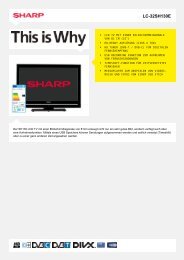r-24st / r-2b34 microwave oven operation manual with cookbook
r-24st / r-2b34 microwave oven operation manual with cookbook
r-24st / r-2b34 microwave oven operation manual with cookbook
Create successful ePaper yourself
Turn your PDF publications into a flip-book with our unique Google optimized e-Paper software.
R-24ST/2B34 ENGLISH 28/3/01 10:00 am Page 21<br />
BROWNING AGENTS<br />
After more than 15 minutes cooking time food<br />
acquires a brownness, although this is not<br />
comparable to the deep brownness and crispness<br />
obtained through conventional cooking. In order<br />
to obtain an appetising brown colour you can use<br />
browning agents. For the most part they<br />
simultaneously act as seasoning agents.<br />
BROWNING AGENT<br />
Melted butter and dried paprika<br />
Dried paprika<br />
Soya sauce<br />
Barbecue and Worcestershire sauce, Gravy<br />
Rendered down bacon fat or dried onions<br />
Cocoa, chocolate flakes, brown icing,<br />
honey and marmalade<br />
Poultry<br />
HEATING<br />
● Ready-prepared meals in aluminium containers<br />
should be removed from the aluminium container<br />
and heated on a plate or in a dish.<br />
● Remove the lids from firmly closed containers.<br />
● Food should be covered <strong>with</strong> <strong>microwave</strong> foil, a plate<br />
or cover (obtainable from stores), so that the surface<br />
does not dry out. Drinks need not be covered.<br />
● When boiling liquids such as water, coffee, tea or<br />
milk, place a glass stirrer in the container.<br />
● If possible, stir large quantities from time to time, to<br />
ensure that the temperature is evenly distributed.<br />
● The times are for food at a room temperature of<br />
20° C. The heating time for food stored in a<br />
refrigerator should be increased slightly.<br />
● After heating allow the food to stand for 1-2<br />
minutes, so that the temperature inside the food can<br />
be evenly distributed (standing time).<br />
● The times given are guidelines, which can be varied<br />
according to the initial temperature, weight, water<br />
content, fat content or the result which you wish to<br />
achieve.<br />
THAWING<br />
Your <strong>microwave</strong> is ideal for thawing. Thawing times<br />
are usually considerably shorter than in traditional<br />
TIPS AND ADVICE<br />
In the following table you will find some<br />
suggestions for substances you might use for<br />
browning and some of the uses to which you might<br />
put them.<br />
Oven baked dishes"Cheese<br />
toasties"<br />
Meat and poultry<br />
Roasts, Rissoles, Small roasted<br />
items<br />
Oven baked dishes, toasted<br />
items, soups, stews<br />
Cakes and desserts<br />
21<br />
DISH METHOD<br />
Coat the poultry <strong>with</strong> the<br />
butter/paprika mixture<br />
Dust <strong>with</strong> paprika<br />
Coat <strong>with</strong> the sauce<br />
Coat <strong>with</strong> the sauce<br />
Sprinkle pieces of bacon or<br />
dried onions on top<br />
Sprinkle pieces on top of cakes<br />
and desserts or use to glaze<br />
methods of thawing.<br />
Here are a few tips. Take the frozen item out of its<br />
packaging and place on a plate for thawing.<br />
BOXES AND CONTAINERS<br />
Boxes and containers suitable for <strong>microwave</strong>s are<br />
particularly good for thawing and heating food, since<br />
they can <strong>with</strong>stand temperatures in a deep freeze<br />
(down to approx. –40° C) as well as being heatresistant<br />
(up to approx. 220° C). You can therefore<br />
use the same container to thaw, heat and even cook<br />
the food, <strong>with</strong>out having to transfer it.<br />
COVERING<br />
Cover thin parts <strong>with</strong> small strips of aluminium foil<br />
before thawing. Thawed or warm parts should likewise<br />
be covered <strong>with</strong> aluminium strips during thawing. This<br />
stops the thin parts becoming too hot while thicker parts<br />
are still frozen.<br />
CORRECT SETTING<br />
It is better to choose a setting which is too low rather<br />
than one which is too high. By so doing you will ensure<br />
that the food thaws evenly.<br />
If the <strong>microwave</strong> setting is too high, the surface of the<br />
food will already have begun to cook while the inside<br />
is still frozen.<br />
ENGLISH


